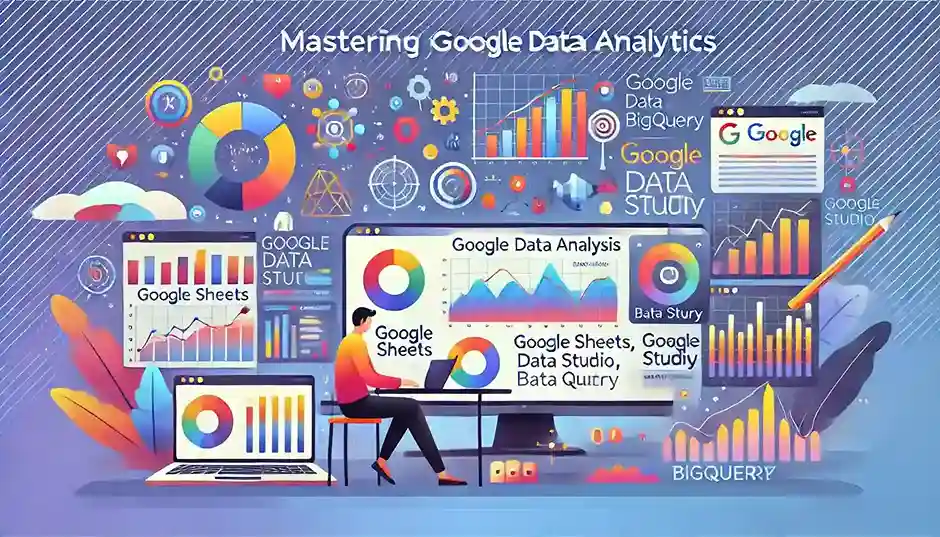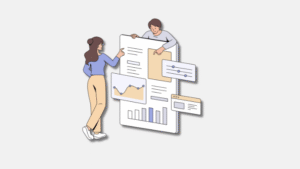As we enter an era where every user interaction is monetarily significant, businesses are compelled to analyze data effectively and transform it into actionable insights, thanks to data analytics tools such as Google Data Analytics.
It is a solution that enables coffee shops, retail businesses, and companies to convert data into a competitive advantage. After this tutorial, you will be fluent in Google Data Analytics, irrespective of your prior experience in the field.
What is Google Data Analytics? 🤔
Google Data Analytics is a course and certification program provided by Google aimed at helping individuals understand the principles of data analytics. It covers topics like gathering and cleaning data, as well as analyzing and visualizing it using Google Sheets, Google Data Studio, and BigQuery. Upon completion, you will be able to understand data, identify areas to visualize, and optimize decision-making using the data.
Why Learn Google Data Analytics? 🏆
There are numerous opportunities that Google Data Analytics presents, as the global market is constantly in need of data-driven decision-makers. Its benefits in the job market include:
- Strong Need: Businesses require data for informed decision-making. With evolving industries, there is always a demand for proficient and skilled data professionals.
- Wide Range of Tools: You will learn how to work with industry-standard tools like Google Sheets, Google Data Studio, and BigQuery.
- Certification Value: Earning the Google Data Analytics Certification adds significant value to your resume, as it is widely recognized by employers.
Let Us Start with Google Data Analytics Beginners Tools 🛠️
Now, let’s dive into the practical aspects and look at the tools you will be using.
1. Data Collection: The Ground Work 🏗️
Before analyzing data, it must be collected. For website monitoring, Google Analytics is the leading service, though there are other options as well.
- Google Analytics: Use this tool to gather audience statistics on your website visitors.
- Google Forms: A web-based application for creating surveys and questionnaires to collect data from users.
- Google Sheets: A digital worksheet application for structured data organization.
2. Data Cleaning: Treat Your Data 🧹
Data cleaning involves removing incorrect, incomplete, or irrelevant data. This is a crucial step before analysis, as dirty data can lead to inaccurate conclusions.
Data Cleaning Steps:
- Remove Duplicates: Check your dataset and remove any duplicate records.
- Handle Missing Values: Use Google Sheets to filter and clean missing data points.
- Standardize Data: Ensure consistent formatting, such as standardized date formats.
3. Google Sheets as a Data Analysis Tool 📊
Google Sheets can be utilized effectively for data analysis. Here’s how you can leverage its features:
- Pivot Tables: Summarize large datasets easily.
- Conditional Formatting: Highlight significant trends or anomalies in the data.
- Functions and Formulas: Advanced analysis can be performed using functions like
SUMIF,VLOOKUP, andINDEX-MATCH.
Pro Tip: Use the FILTER function to quickly find specific data points.
4. The Use of Google Data Studio in Data Visualization 🖼️
Data visualization involves presenting collected data in an attractive manner to facilitate stakeholder interpretation.
- Google Data Studio: A robust tool for creating interactive dashboards.
- Charts and Graphs: Use bar charts, pie charts, and line graphs for visual data representation.
- Custom Reports: Tailor reports to meet the specific needs of your audience.
Quick Tip: Use clear titles on graphs and charts to enhance understanding.
5. BigQuery is Big Data 🔍
For large datasets, Google’s BigQuery is the preferred tool. It allows for fast and efficient execution of SQL queries.
Key Features of BigQuery:
- Scalability: Easily manage and analyze large-scale datasets.
- Speed: Perform complex queries within seconds.
- Integration: Seamlessly connect with other Google tools like Data Studio and Google Sheets.
SQL Example:
SELECT COUNT(*) AS user_count FROM `project.dataset.table` WHERE country = 'United States';
6. Writing An Impactful Data Analytics Report 📝
Data analysis includes report writing, where major findings are effectively consolidated.
What You Need To Include in the Report:
- Executive Summary: An overall statement of the key findings.
- Data Visualizations: Illustrate important trends using graphs or charts.
- Suggestions and Recommendations: Provide actionable insights based on the analysis.
Suggestions for Google Data Analysts to Succeed 🚀
- Regular Practice: Get hands-on experience with plenty of data.
- Do Not Fall Behind: Keep your knowledge up to date with the latest tools and techniques.
- Be A Part of a Team: Collaborate with other data analysts for guidance and insights.
Google Data Analytics Certification: Benefits In Career Perspective 🎓
Coursera offers a professional certification in Data Analytics. Here’s why you should consider taking it:
- Progression in Learning Path: The course guides you from basic concepts to advanced topics.
- Experience First Hand: Work on real projects and case studies.
- Recognized Certification: The course is developed by Google and is widely recognized in the industry.
How To Prepare for the Google Data Analytics Exam 📝
- Self-Study: Go through all the lessons and take notes.
- Practice Datasets: Use Google Sheets or BigQuery for hands-on practice.
- Mock Tests: Familiarize yourself with the exam format by taking mock tests.
FAQs: Google Data Analytics 🧐
1. What is Google Data Analytics?
Google Data Analytics is a certification program that teaches the principles of data analysis using tools like Google Sheets, Data Studio, and BigQuery.
2. How long does it take to earn the Data Analytics Certification?
It typically takes about 6 months to complete the course, dedicating around 10 hours per week.
3. Is Google Data Analytics Certification worth it?
Absolutely. It is highly valued by employers and equips learners with practical skills needed for entry-level data analyst roles.
4. What are the job opportunities after Data Analytics?
You can pursue roles like Data Analyst, Business Analyst, and Data Visualization Specialist, among others.
5. Do I need prior knowledge about data analytics to enroll in this course?
No, the course is designed for beginners. Basic knowledge of statistics and spreadsheets may be helpful but is not mandatory.
6. What professional software applications will I learn in Google Data Analytics?
You will learn to use Google Sheets, Google Data Studio, BigQuery, and SQL.
Conclusion 🎯
It is clear that Google Data Analytics is an essential skill set for making quick, data-driven decisions in today’s business landscape. Mastering these tools allows you to analyze data in detail, visualize the results, and provide actionable recommendations for improving organizational performance.
So why procrastinate? Embark on your journey with Google Data Analytics and unlock a world of opportunities! 🌐💼




